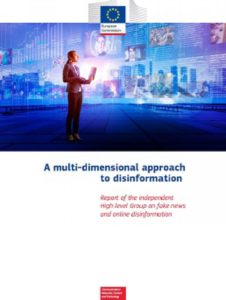
While tackling the scourge of disinformation, governments and other parties should avoid interfering with the freedom of expression and free media, according to a report from the European Commission’s High-Level Expert Group on Fake News and Disinformation, published on Monday (March 12):
The report calls for online platforms to be more transparent and for media literacy to be promoted, while warning against any simplistic solutions to the problems of disinformation. It also made a plea for more tools to empower users and journalists to tackle disinformation, and for the diversity and sustainability of news media to be safeguarded.
The multi-dimensional approach recommended by the HLEG is based on a number of interconnected and mutually reinforcing responses. These responses rest on five pillars designed to:
- enhance transparency of online news, involving an adequate and privacy-compliant sharing of data about the systems that enable their circulation online;
- promote media and information literacy to counter disinformation and help users navigate the digital media environment;
- develop tools for empowering users and journalists to tackle disinformation and foster a positive engagement with fast-evolving information technologies;
- safeguard the diversity and sustainability of the European news media ecosystem, and
- promote continued research on the impact of disinformation in Europe to evaluate the measures taken by different actors and constantly adjust the necessary responses.
 Group chairman Madeleine de Cock Buning — a Dutch professor of copyright and media law — said the experts were advising the opposite of a blacklist. “For us, freedom of the press is the most important aspect,” she said. “What we do advise is fact checking. But we advise that in a very transparent an open sourced kind of way.”
Group chairman Madeleine de Cock Buning — a Dutch professor of copyright and media law — said the experts were advising the opposite of a blacklist. “For us, freedom of the press is the most important aspect,” she said. “What we do advise is fact checking. But we advise that in a very transparent an open sourced kind of way.”
The most extensive analysis of fake news has found that “for all categories of information — politics, entertainment, business and so on —false stories spread significantly farther, faster and more broadly than did true ones,” notes Sinan Aral (@sinanaral), a professor at the M.I.T. Sloan School of Management.
Falsehoods were 70 percent more likely to be retweeted, even when controlling for the age of the original tweeter’s account, its activity level, the number of its followers and followees, and whether Twitter had verified the account as genuine, he writes for the New York Times:
A more robust identification of the factors that drive the spread of true and false news will require direct interaction with users through interviews, surveys and lab experiments. We could also benefit from randomized controlled trials of efforts to dampen the spread of false stories…..Some notion of truth is central to the proper functioning of nearly every realm of human endeavor. If we allow the world to be consumed by falsity, we are inviting catastrophe.







